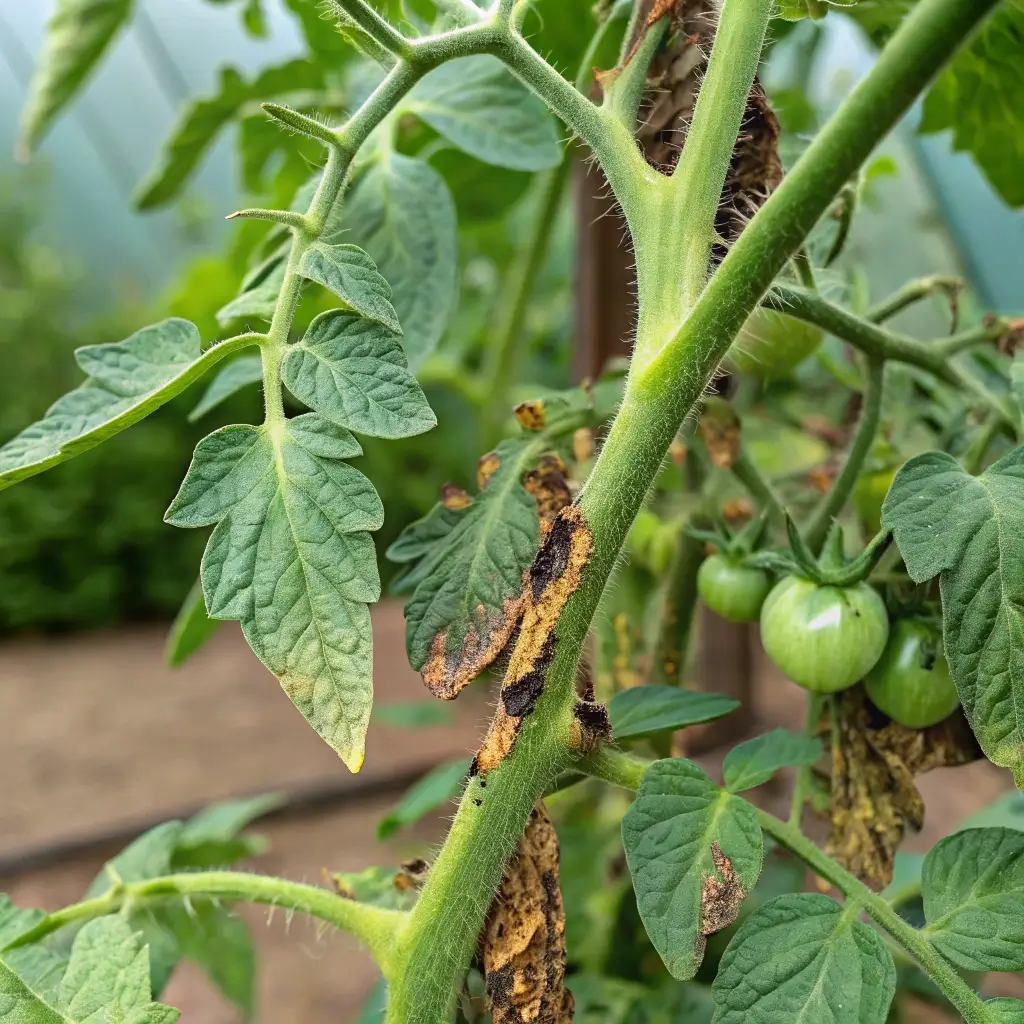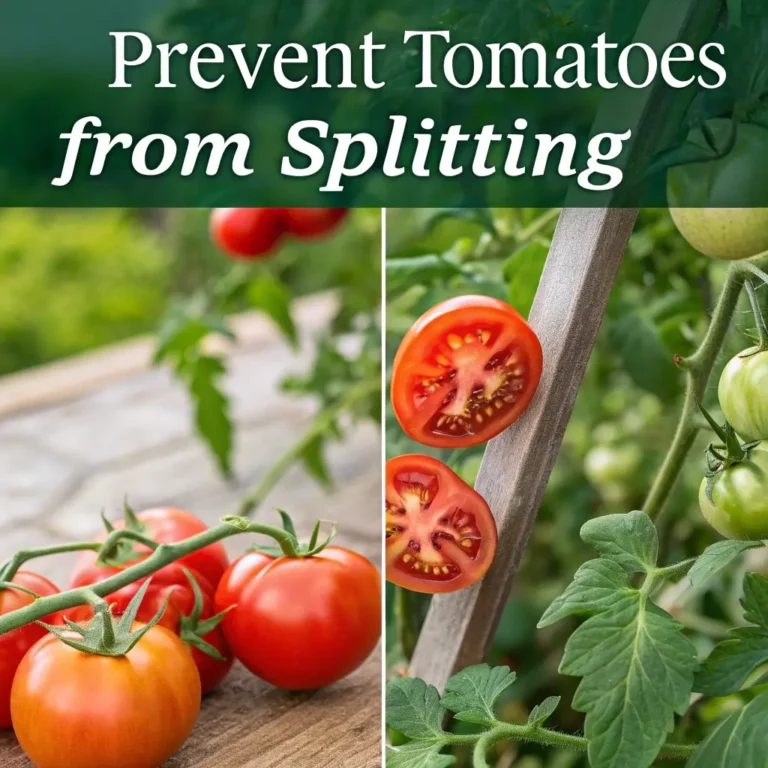Why Tomato Plant Stems Turning Black? 3 Causes and Fixes
Table of Contents
Introduction
Have you noticed your thriving tomato plants suddenly developing disturbing black patches along their stems? You’re not alone. According to recent horticultural surveys, nearly 40% of home gardeners report experiencing tomato stem blackening issues each growing season. This widespread problem can quickly transform a promising harvest into a disappointing failure if left untreated. Why are tomato plant stems turning black? The causes often relate to fungal infections, bacterial diseases, or environmental stressors—each requiring specific solutions to save your precious plants. Let’s dive into the most common culprits behind this alarming symptom and explore proven remedies that can help restore your tomatoes to their healthy, productive state.
Common Causes of Black Tomato Stems
1. Early Blight (Alternaria solani)
Early blight is a fungal disease that often begins on lower leaves but can spread to stems, creating distinctive black or brown lesions with concentric rings. This fungus thrives in warm, humid conditions and can overwinter in soil debris.
Identification Signs:
- Dark, target-like spots on leaves
- Black lesions on stems with concentric rings
- Yellowing leaves that eventually die
- Most severe during warm, wet periods
Solution: Apply a copper-based fungicide every 7-10 days when symptoms first appear. Remove infected leaves and stems immediately. Implement crop rotation, avoiding planting tomatoes in the same location for 3-4 years.
2. Bacterial Black Spot (Pseudomonas syringae)
This bacterial infection typically appears after periods of cool, wet weather and can spread rapidly throughout your tomato plants.
Identification Signs:
- Water-soaked black spots on stems
- Lesions that may ooze under humid conditions
- Rapid spread during wet weather
- Wilting despite adequate soil moisture
Solution: Remove and destroy infected plants to prevent spread. Avoid overhead watering to keep foliage dry. Apply a copper-based bactericide according to label directions. Ensure good air circulation by proper spacing between plants.
3. Environmental Stress or Physical Damage
Sometimes what appears to be disease is actually the plant’s response to environmental factors or physical injury.
Identification Signs:
- Black stems appearing after extreme weather events
- Darkening near pruning cuts or damaged areas
- Concentrated blackening near soil line after heavy rains
- Black spots developing after handling plants
Solution: Provide consistent watering and protect plants from extreme weather conditions. Use clean, sharp tools when pruning to avoid creating entry points for pathogens. Add mulch to prevent soil splashing onto stems during watering or rain.
Prevention Strategies
Proper Planting Techniques
Start with healthy plants and proper spacing to ensure good airflow. Plant tomatoes in well-draining soil with adequate organic matter. Studies show that tomatoes planted with proper spacing (at least 24 inches apart) experience 60% fewer stem diseases.
Water Management
Proper watering techniques can dramatically reduce stem blackening issues. Water at the base of plants, preferably in the morning, to allow foliage to dry quickly. Avoid overhead watering which creates favorable conditions for fungi and bacteria.
Pro Tip: Install a drip irrigation system to deliver water directly to roots, reducing leaf wetness by up to 85% compared to overhead watering methods.
Mulching Benefits
Apply a 2-3 inch layer of organic mulch around plants to prevent soil-borne pathogens from splashing onto lower stems. Research indicates that properly mulched tomato plants have 70% less incidence of stem diseases compared to unmulched plants.
Treatment Options
Organic Solutions
For gardeners preferring organic approaches:
- Neem oil applications every 7-10 days
- Compost tea sprays to boost plant immunity
- Milk spray (1:9 ratio of milk to water) applied weekly
- Beneficial bacteria products containing Bacillus subtilis
Chemical Controls
When organic methods aren’t sufficient:
- Copper-based fungicides for both bacterial and fungal issues
- Chlorothalonil products for fungal infections
- Mancozeb for severe early blight infestations
- Systemic fungicides for advanced cases
When to Remove Plants
Sometimes infected plants cannot be saved and must be removed to protect others. Consider removal when:
- More than 50% of the plant shows blackening
- Stems become soft and collapse
- Blackening is spreading rapidly despite treatment
- Other plants begin showing similar symptoms
Long-Term Garden Management
Crop Rotation
Implement a 3-4 year rotation cycle for tomatoes and related plants (peppers, eggplants, potatoes). This practice can reduce disease pressure by up to 80% in home gardens according to extension research.
Soil Health
Maintain soil pH between 6.2-6.8, which creates less favorable conditions for many pathogens. Regular addition of compost improves soil structure and introduces beneficial microorganisms that compete with pathogens.
Resistant Varieties
Consider planting disease-resistant tomato varieties in future seasons. Look for varieties with resistance codes such as “EB” (Early Blight) or “BS” (Bacterial Speck) on seed packets or plant labels.
Conclusion
Understanding why tomato plant stems turn black is the first step toward solving the problem. Whether dealing with fungal pathogens, bacterial infections, or environmental stress, prompt identification and appropriate intervention can save your plants and protect your harvest. By implementing the preventative measures and targeted treatments outlined above, you can significantly reduce the occurrence of blackened stems and enjoy healthier, more productive tomato plants. Remember that consistent monitoring is key—catching problems early can mean the difference between minor damage and total crop loss.
FAQs
Can tomatoes from plants with black stems still be eaten?
Yes, fruits from affected plants are generally safe to eat if they show no signs of disease themselves. However, yields may be reduced, and fruits may be smaller due to plant stress.
How quickly can stem blackening kill a tomato plant?
Depending on the cause, severe stem blackening can kill a plant within 2-3 weeks if left untreated, especially during hot, humid weather when pathogens spread rapidly.
Will stem blackening spread to other garden vegetables?
Early blight and some bacterial diseases can affect other members of the nightshade family (peppers, eggplants, potatoes) but usually won’t spread to unrelated plants like cucumbers or beans.
Is it safe to compost tomato plants with black stems?
It’s not recommended, as disease organisms can survive in compost that doesn’t reach high enough temperatures. Dispose of severely infected plants in the trash instead.
Can I plant tomatoes in the same spot next year if I had stem blackening issues?
It’s best to practice crop rotation and wait 3-4 years before planting tomatoes in the same location. If space is limited, replace the top 4-6 inches of soil and add fresh compost before replanting.







